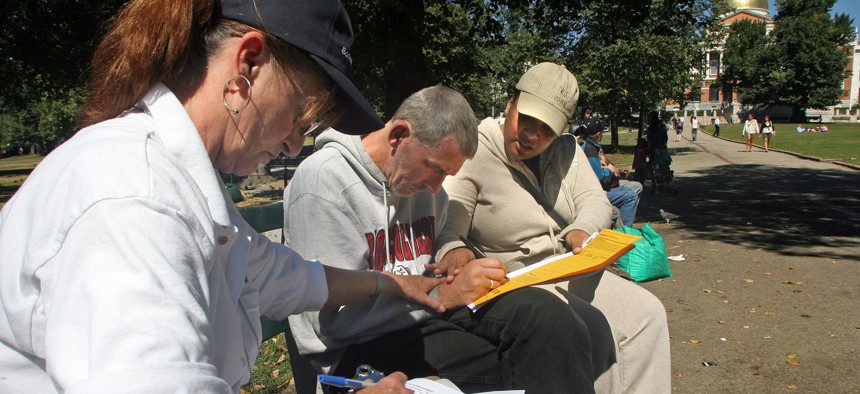For homeless services staff, fulfillment doesn’t pay the bills

Lynne Jones of the Boston Housing Authority and Sabra Johnson, a case manager at the Woods Mullen Shelter, help steady the hand of James Michael"JD" DiRosa as he signs up for a permanent housing program. Nancy Lane/MediaNews Group/Boston Herald via Getty Images
A survey of more than 5,000 U.S. homeless services workers found that 12% qualify for food stamps and 9% for housing vouchers.
Burned out. Discouraged. Unmotivated. Underappreciated.
These are just a few of the phrases people working in homeless services recently used to describe their experiences in the field.
Many join the sector wanting fulfilling and meaningful work. But as staff shortages and low pay make a stressful job even more draining, homeless services organizations are looking to governments to help them retain those dedicated to ending homelessness.
A new report from the National Alliance to End Homelessness paints a grim picture of what those low salaries mean for hiring and retaining staff. A survey of more than 5,000 workers in all 50 states and Washington, D.C., found that 12% of workers qualify for the Supplemental Nutrition Assistance Program and 9% for housing vouchers. Given today’s high cost of living, even those who don’t qualify for such programs are struggling to make ends meet, with one in three workers saying they don’t earn enough to meet their basic needs.
The new report follows an earlier analysis that found the homeless services sector faces a deficit of at least $4.8 billion to adequately pay current workers.
Those challenges have alarming impacts in the field. Thirty-seven percent of workers said they’re considering leaving their jobs, with low salary and poor benefits by far the most cited reasons. Nearly three in four respondents said their organization was understaffed, with 71% noting high turnover was a problem in their workforce.
“We just won't be able to reduce homelessness in the ways that we would like or solve the problem unless we have the people there to deliver the services,” said Joy Moses, the alliance’s vice president of research and evidence. “We're in a critical shortage at the moment, and our systems are at risk,” she said. “It's something that we can't ignore anymore.”
Many homeless services staff members have completed higher education programs—39% have bachelor’s degrees and 26% have master’s—but without the pay to match.
And it’s not just the bleak financial prospects pushing people out of the field; the work takes an emotional toll as well. With the growing numbers of homeless individuals, 69% of respondents said they “experience significant stress rooted in not being able to help enough people.” Nearly half reported feeling overworked, and many noted they aren’t able to take time off.
Vacancies and turnover affect the quality of those who remain on staff. “We keep toxic staff due to staffing issues because it’s hard to fill positions,” one respondent said. Staffing shortages also increase an organization’s reliance on volunteers who may not bring the commitment and expertise a paid worker offers.
It’s a downward spiral from there. When services fall short due to understaffing, there’s potential for reduced funding, which makes it even harder to hire and retain workers.
Many of the homeless services workers responding to the survey had experienced homelessness in their own lives, and they entered the professions out of a desire to prevent others from similar hardships, Moses said. Despite the challenges associated with the field, more than 80% of respondents said the best parts of their jobs were relationships with coworkers and clients.
“We have people who are worried about how they're going to pay their own rent, but they are simultaneously worried about putting clients and their well-being at the top of their list,” Moses said.
Many communities across the country are having conversations about housing for teachers, police officers and other public servants, who struggle to make ends meet with their low-paying jobs. Moses said homeless service workers should also be included in those conversations and localities should be taking a comprehensive approach to workforce housing.
State and local governments can make investments to support workers outside of salary increases. Many respondents said they would like more paid time off, training and homebuyer assistance programs.
State-level leadership can also be powerful, Moses said, and states should step up instead of relying on local governments and continuums of care to tackle the crisis alone. In California, for instance, the Newsom administration has invested in researching homelessness across the state, funded different housing solutions and supported local governments in their efforts.
The federal government, however, “packs the biggest punch” when it comes to addressing many of the issues in the homeless services field, the report noted. One way to relieve the workforce crisis would be to reduce administrative burdens. Federal agencies could revamp time- and personnel-intensive application processes from an annual affair to every few years.
But while the feds may have the most resources and power to make a dent in homelessness, it’ll take all hands on deck to end the crisis.
“Every level of government and the private sector has a role to play in addressing the problem,” Moses said. “It's a big one.”
NEXT STORY: How to hire faster in the public sector






